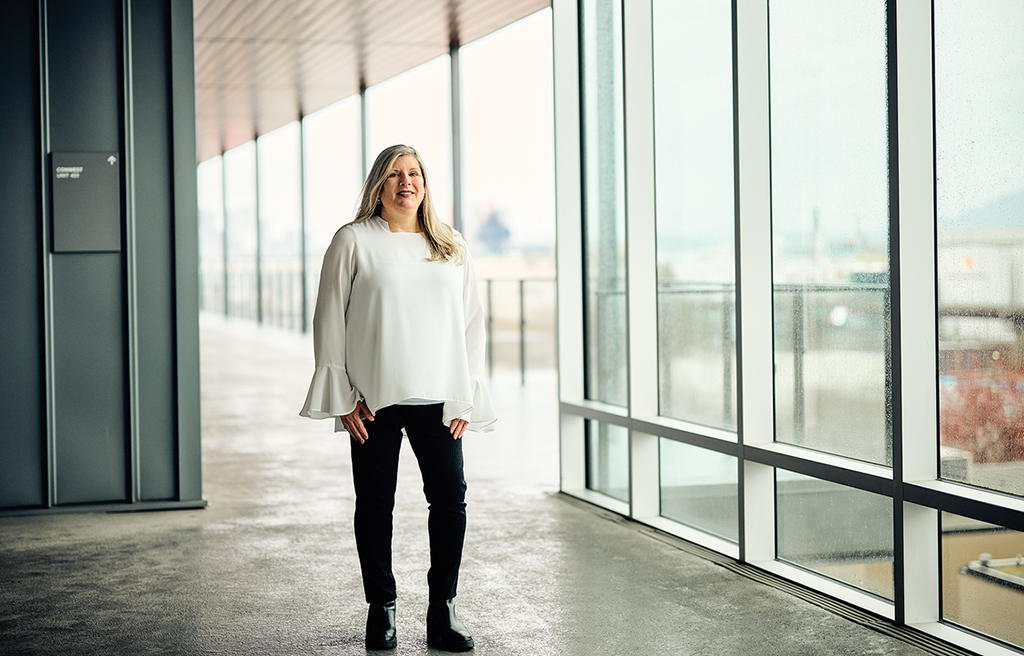 VP of Conwest Developments Kim Maust is excited to see more women moving into the sector
VP of Conwest Developments Kim Maust is excited to see more women moving into the sector
BC Business
Frances Bula
Kim Maust had zero dreams of becoming a major player in the real estate world when she was a girl or even in her more grown-up 20s.
Back then, she, in her words, “married a Mennonite boy and part of the culture was voluntary service.” She worked on Habitat for Humanity housing projects in Ontario, then ended up in Vancouver wrassling a particularly difficult development—a large apartment building with retail on the bottom at Charles Street and Commercial Drive—into completion. She found she liked the challenge.
A lot of people in the development industry then, AKA men, didn’t take her too seriously. Until it became clear to them that she was the one deciding to pay their structural engineering invoice or agree to their contract terms.
But things changed slowly. After moving from Habitat to a receptionist job at Bastion Development in 1997, she became vice-president three years later, and logged 20 years there working on everything from small townhouse projects to the massive remake of the historic Opsal Steel building near the current Olympic Village.
Now, as a vice-president at Conwest Developments (those in Vancouver might know its cool new building that houses Mount Pleasant Vintage & Provisions), she oversees everything from marketing to concrete pouring to tracking all spending on her set of projects via Excel. She currently has half a dozen developments, mostly the industrial that Conwest specializes in, plus a few residential—in Surrey, Vancouver and New Westminster—that represent close to a billion dollars all in.
“I really enjoy being a woman in the development industry,” Maust says. And she’s not alone. There are far more women moving into this lucrative and prominent sector of the B.C. economy than you might think. Women who started out as accountants or retail managers and then found themselves in development where, before long, they were overseeing multi-million-dollar projects.
That’s not always visible to outsiders or even reporters like me. The people who speak for the development industry in public are frequently men from the small circle of developer families that have dominated Vancouver: the Aquilinis, the Bosas, the Cresseys, the Grants at PCI, the Mackays at Strand Development, the De Cotiis brothers with their Onni, Amacon and Pinnacle International companies—people I’ve been talking to and quoting for the last 25 years.
But there are more and more women out there all the time, increasing rapidly not just in numbers but in the senior positions they hold. They’re not confined to the marketing departments where they used to be found most frequently.
The local chapter of CREW (Commercial Real Estate Women Network) has about 220 members, many of them in senior positions at heavy-hitting firms.
“Women are coming from a wide variety of backgrounds,” says Tina Lu, the CREW Vancouver chapter’s current president and the director of retail investments at the B.C. government’s real-estate investment arm, QuadReal Property Group, with $70 billion in global assets under management. “We have people who don’t come from that real estate background. It’s not only architecture school or MBAs.”
The group put on 36 events last year, ranging from leadership advice to awards to a seminar on “not being over-apologetic,” says Lu. They give out scholarships, provide mentors and create a place for women to connect with each other. “It provides a really safe space in this industry to ask the tough questions and find mentors.”
They also share the research that CREW, an international organization with 12,000 members, puts out about women in the development industry—the most comprehensive research there is on numbers, pay equity and the like.
Those women in the local CREW chapter aren’t all the women in the industry. Tracy McRae, a vice-president of development at Eric Carlson’s Anthem Properties, hasn’t joined the CREW group because she does mostly residential, not commercial. But she’s equally enthusiastic about the field.
McRae, who started professional life as an accountant, said she got lured into development by an engineer friend and hasn’t regretted it: “I don’t get bored. You never know what’s going to come up next. I love the variety, I love multi-tasking.” That ability to track many things at once is something she thinks women are inclined to be good at. “It’s a bit inherent in our DNA.”
Like Kim Maust, McRae emphasizes that it’s a demanding sector, one that is all about performance, not some standardized set of credentials or how well you write a report. In the current climate, where interest rates and construction costs are moving steadily up and costing millions for the kinds of projects she works on, along with the usual snakes-and ladders game that development goes through to get community and municipal-council approvals, it means being able to withstand a lot of adversity and stress.
She currently has five projects in her portfolio and is responsible for driving forward all the development design and approvals. “It’s fun, but it’s a lot of work. You have to be relentless and just keep going,” says McRae.
While everyone says that the proportion of women now is light years away from what it was a couple of decades ago, there still needs to be change. “We’re not quite there yet. There’s still a bit of a gap,” says Lu. “It’s a work in progress.”


